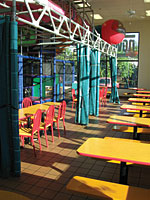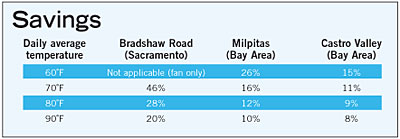
This group performed an economic analysis of DCV with the help of a computer simulation known as the Ventilation Strategy Assessment Tool (VSAT). The analysis was designed to determine the conditions under which DCV is most likely to be cost-effective.
In addition, field tests were conducted to verify the savings and identify potential problems in the application of DCV (see Figure 1). The results also included a set of design recommendations.

Features
Analysis of DCV systems coupled with economizers covered a variety of new and existing buildings with a wide range of occupancy schedules. The sites included a small office building, a sit-down restaurant, a retail store, and several school spaces - a class wing, an auditorium, a gymnasium, and a library. In all cases, the DCV-plus economizer system showed greater savings and quicker payback than an economizer-only system. Payback periods were typically two years or less.Field tests conducted in coastal and inland climate zones in California included sites such as McDonald's PlayPlace areas, modular school rooms, and Walgreens drug stores. The largest savings occurred in inland buildings with low occupancy rates and high ventilation loads (see Table 1 and Figure 2).
According to the team's report, no substantial savings were found in buildings with high occupancy rates that varied only a little, such as modular school rooms. Also, timers or controllable thermostats meant that HVAC units only operated during normal school hours.
According to the project team, several conclusions from the study can help designers decide where and how to implement DCV:

The VSAT tool is available for evaluating the impact of set points, minimum ventilation rates, and operating schedules during the DCV system design phase. (The program can be downloaded from the Web at www.energy.ca.gov/pier/buildings/tools.html.)

Applications
The DCV technology evaluated in this project is used on packaged air conditioning systems, which are typically found in small commercial buildings. Facilities likely to benefit from DCV include auditoriums, gyms, and re-tail stores, the study said.Meanwhile, the changes to Title 24 that took effect in California on Oct. 1, 2005, require DCV in all spaces where an HVAC single-zone system includes an economizer and that has an occupant density of greater than or equal to 25 people per 1,000 square feet. Exceptions include classrooms, areas where space exhaust is greater than the design ventilation rate, and spaces with processes or operations that generate dust, fumes, mists, vapors, or gases. The new code also requires acceptance tests to ensure the technology is properly installed.
In the end, as interest in DCV increases, the project team concluded that its impact on comfort and productivity should be studied to provide additional information for designers and building owners.
Reports documenting this project and providing more details may be downloaded from the California Energy Commission Web site at www.energy.ca.gov.
Publication date: 12/05/2005

Report Abusive Comment